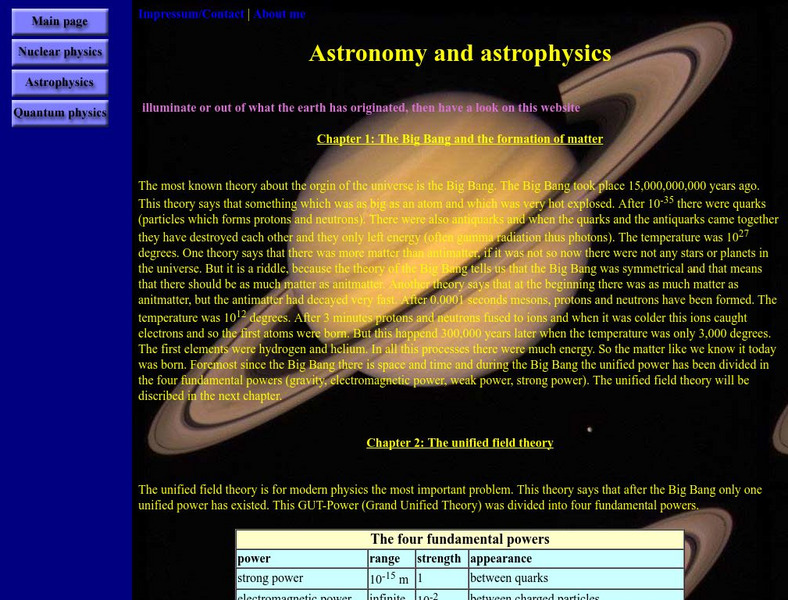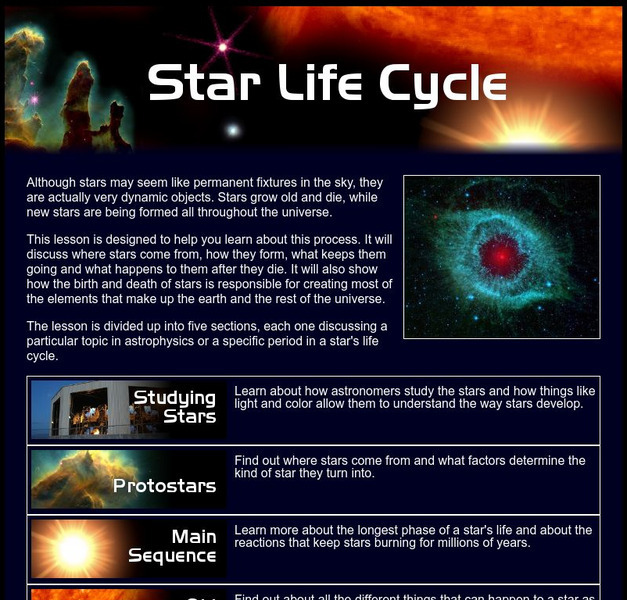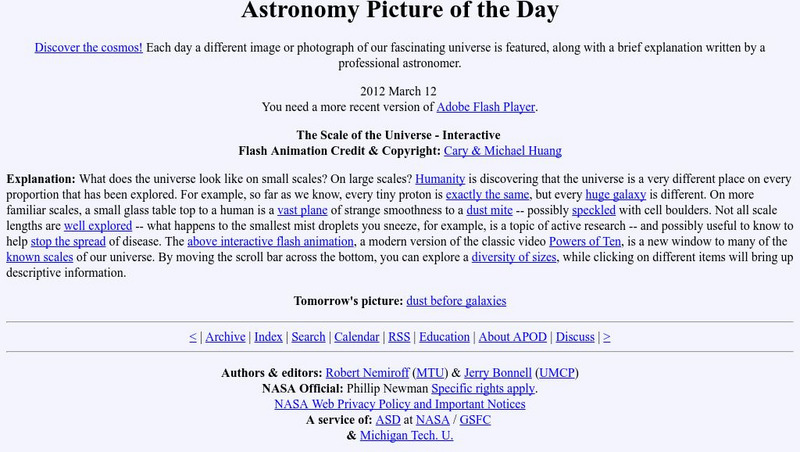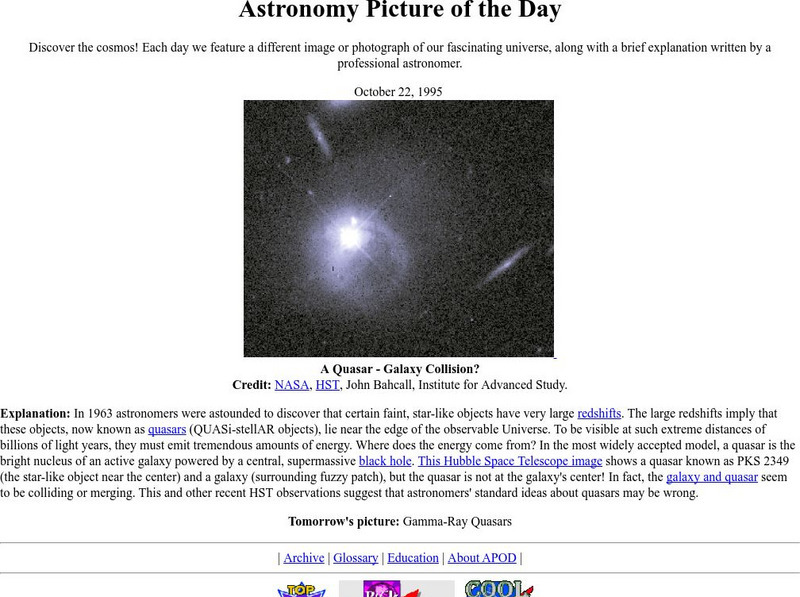Other
Jack Horkheimer: Star Gazer
This is a site on astronomy in general. If you are into astrophotography, you can find out what is happening in the heavens! Jack Horkheimer is also seen on PBS. You can access the 5 or 1 minute shows on this site.
Other
Astronomylinks
This is a very comprehensive site on the subject of Astronomy and Astrophysics. The site has links to many sites on topics including astronauts, astronomy, astrophysics, education, jobs, etc.
Other
Astronomy and Astrophysics
This site is about Astronomy and Astrophysics. The site has plenty of information and links to related topics.
Other
Noao: Faq's About Being an Astronomer
Do you love to look at the stars? Explore commonly asked questions about becoming an astronomer.
Other
Institute of Physics: Practical Physics
Access hundreds of teacher-tested, practical physics lessons on this well-organized, illustrated site. Find just the right demonstration, attention-grabber, or lab for any physics teaching objective at your fingertips.
Other
Jodrell Bank Centre for Astrophysics: A Tutorial on Radio Pulsars
A extensive site that describes the history of the discovery of pulsars along with definitions, characteristics, locations, and distances of pulsars, plus much more.
University of Utah
University of Utah: Aspire: Life Cycle of a Star
Experience this impressive interactive website about the life cycle of a star.
California Institute of Technology
Caltech Astronomy: Light Pollution and the Palomar Observatory
Learn about light pollution, how it is created, and it's negative impact on astronomical observatories, in particular, the one on Palomar Mountain, California. From the Caltech astronomy department this is an informative look at the...
University of Oregon
Stellar Evolution: White Dwarfs
Brief discussion of white dwarfs, their discovery, and evolution.
Science Buddies
Science Buddies: What Makes the Rings of Saturn?
Saturn is a unique planet because of the many beautiful rings surrounding it. How are all of those rings made? Why is each ring unique?
Other
Center for Educational Resources: Sky Paths
Lesson activities where students observe and describe the movements of objects in the sky in both daytime and nighttime. They learn how early cultures regarded the skies, and the stories they told about them. Students will be given the...
Other
Wisconsin/ Surf Report/web Sites
Wisconsin Educational Communications Board provides numerous links to educational web sites for students and teachers. Its subjects include art, animals, astronomy, Black history, careers, children's books, dinosaurs, environmental...
Other
Wisconsin/ Surf Report/web Sites
Wisconsin Educational Communications Board provides numerous links to educational web sites for students and teachers. Its subjects include art, animals, astronomy, Black history, careers, children's books, dinosaurs, environmental...
Science Buddies
Science Buddies: Where Did All the Stars Go?
If you live in a big city or urban area it is hard to see many stars at night. In most urban areas only the most brilliant stars, planets and the moon can be seen. This is because of something called light pollution which is the...
Science Buddies
Science Buddies: The Moon and the Stars
When you are in the city, only a few of the brightest stars are visible. But when you are in the country, you can see many more stars than you can count. Sometimes you can even see the bright belt of our galaxy, the Milky Way. In this...
University of Arizona
University of Arizona: Department of Astronomy and Steward Observatory
The University of Arizona operates Steward Observatory research website and the Department of Astronomy academic website.
NASA
Nasa: Astronomy Picture of the Day: Gamma Ray Quasar
A photograph and description of quasar 3C279 viewed in gamma-rays. It was unexpectedly discovered and was one of the brightest objects in the gamma-ray sky until it suddenly faded.
NASA
Nasa: Astronomy Picture of the Day: A Milestone Quasar
An image of a typical quasar and a star. An explanation written by a professional astronomer is included. There are also many embedded links within the text to related topics.
NASA
Nasa: Astronomy Picture of the Day: Edwin Hubble 1889 1953
Part of the NASA website, this is a reprint of an article in the Journal of the Royal Astronomical Society of Canada about Edwin Hubble's life and accomplishments, stressing his role in the development of modern astronomy.
NASA
Nasa: Astronomy Picture of the Day: Scale of the Universe 2
This stunning interactive allows you to explore everything in this universe by zooming into different objects, organisms, and microscopic matter.
NASA
Astronomy Picture of the Day: Quasar Galaxy Collision
An image of a quasar. The large redshifts imply that quasars lie near the edge of the observable universe and must emit tremendous amounts of energy. There are also many embedded links to related topics.
NASA
Astronomy Picture of the Day: Supernova 1987 A
Details of the brightest supernova of modern times - supernova 1987A in the Large Magellanic Cloud. There are many links for additional information.
Other
Hands on Universe (Hou)
HOU trains teachers in how to use astronomy tools and its curriculum materials for science education. HOU is now part of GHOU, or Global Hands-On Universe, and is linked to astronomy scientists in countries all over the world. A world...
Harvard University
Harvard Smithsonian Center for Astrophysics
This resource presents information on the Harvard-Smithsonian Center for Astrophysics. There are links to research, events, facilities, press releases, etc.






















